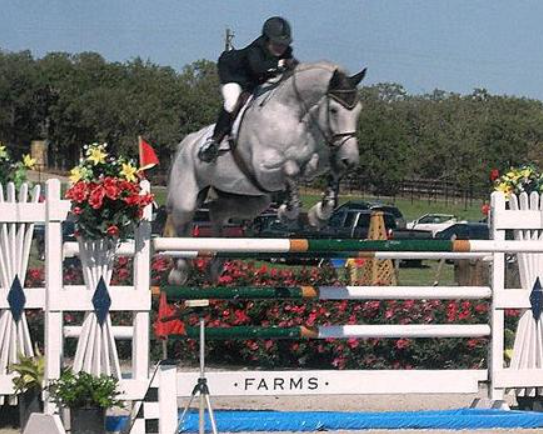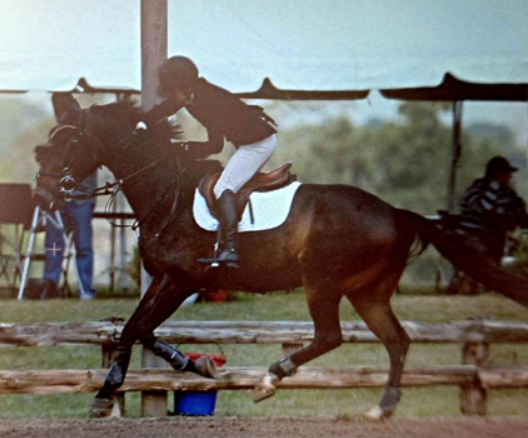Meet Wendy Lee Thompson
Wendy has been training horses for more than 25 years including an extended period of time as a private coach, rider, and trainer for several families across the United States and Europe training horses from baby green hunters to grand prix jumpers. She also coached the members of those families as junior and amateur riders preparing them for competition of all levels throughout the United States.
Now, Wendy owns and operates Coastline Hunters & Jumpers out of Rancho Cielo Equestrian Facility in Rancho Santa Fe, CA. Wendy is an active competitor on the West Coast Rated Hunter/Jumper Circuit, campaigning her mare “Simpatica 33” in the upper level jumpers and Regional and American Standard Grand Prix, as well as developing horses in the Young Jumper and Young Hunter divisions. The foundation for Coastline’s training program is deeply rooted in Wendy’s philosophy that horses must be sound, fit, and happy to perform at their best. Wendy’s patience and feel for the horses needs instills trust and confidence in her horses and she has been able to transform horses that were difficult and unmanageable to happy willing partners . Wendy’s program and style has earned her a strong reputation for equine rehabilitation.
Wendy emphasizes consistency that allows for a gentle and natural progression when training horses, which also translates into her teaching style that reinforces a strong foundation of riding basics and instills confidence in her students. Wendy enjoys sharing her horsemanship knowledge as she produces educated riders of all levels.
California Riding Magazine
Check out the article published in California Riding Magazine about owner/head trainer Wendy Lee Thompson and her horse Simpatica 33!
The Power Of Patience
A project horse becomes a graduate course in horsemanship for San Diego trainer.
To an outsider, Simpatica 33’s fourth-place finish in her first Grand Prix, The $24,500- Del Mar Finale Prix in October, might have looked like an overnight sensation. But the 10-year-old mare’s story is anything but. In fact, her five-year journey to the Grand Prix ring has been a graduate course in horsemanship for veteran trainer Wendy Lee Thompson of Coastline Hunters & Jumpers.
Here’s their story…
By Wendy Lee Thompson
I bought Simpatica at the end of her 5-year-old year and she had never jumped. Sired by the well-known Dutch stallion, Emillion, she was bred to be a dressage horse but she did not have the temperament for it so they tried her at jumping.
I saw her at her first show doing the .70M jumpers. She was very green and never jumped a single jump the same way but she looked very careful. She looked interesting. I was not at all in the market to buy a horse, but when I was approached about her I agreed to look at her and give her a try. I trotted a cross-rail twice and then trotted one vertical and got off. I felt she was very special but she was hard to ride: very spooky, extremely athletic, ultra-careful and super sensitive.
I liked her but I knew she was not a commercial horse to re-sell. I understood she would be a project. I offered half of what they were asking because I felt that not many people were going to want this kind of project. The seller didn’t argue and now I owned her.
The first year with her I had buyers remorse! She was so hard to ride. When I got on her she would run off and if I tried to hold her still, she felt like she would rear. I felt she knew how to do that and had it in her. She was very light on her feet and she would not accept any pressure. She did not like people and she was extremely defensive about her head. I honestly did not know what to do with her. But I did know what not to do. I knew not to put any pressure on her. She felt like she could be dangerous if you pushed the wrong button. I rode her very loose. I let her nose be in front of the vertical and let her be behind the leg to start. If I allowed her to be behind the leg, she would slowly allow some leg contact and gradually be in front of the leg. It’s different but it works.
I did not use spurs, I never asked for a lead change and we stayed in the 1M jumpers for a year and a half. Her natural stride was about 15 feet long and she is built like a deer. She jumped so far past the jump on the landing side I really didn't feel comfortable doing more than that and she was not adjustable. She wanted to be ridden in the two point with very little hand and no leg .On top of this, she was so spooky she would freeze and not go forward sometimes and I had to be very careful about applying leg to get her past that.
She was tricky. I felt I should just concentrate on her relaxing. That meant letting her have freedom and little pressure. There were times I didn't think I had enough skill to ride her. She is so athletic and she could get you off in a moment’s notice if she wanted to. I was cautious and respectful of her ability.
I was thinking I would like to run into someone like Richard Spooner. I thought he would be able to ride her. But I never crossed paths with him. About a year and a half later, a man who knew her well before I got her saw us together at a show and asked, “How did you get her to be so happy?”
The man confirmed a feeling that I always had: Simpatica had not been treated well. “She hated her life and hated to be ridden,” is what he told me. He also told me she was frequently reprimanded with whips and reared. I did not know this about Simpatica’s past, so it gave me more insight and helped me understand her better. I explained to him how my low-pressure approach helped me work with her, and how I let her dictate what we would and would not do.
By 2014, we were starting to do 1.15-1.20M jumper classes pretty well. She would spook and look at things in the ring sometimes, making it hard to get to the first jump. To get her attention, I would develop a strong gallop far away from the start of the course. If I could do that, she wouldn't notice a lot of things and that would help set the tone for the rest of the course and I would get around.
I was schooling 1.35 - 1.40M at home at the gallop and some people started to be interested in her as a Grand Prix prospect. She was tried twice that year and after both trials, she shut down. The last one took six months to get her back together. She was defensive again and everything I asked of her was “No.” She was angry again and very mad at me.
Throughout my time with her, people always suggested draw reins, shadow rolls, blinders, stronger bits, etc. They told me at this point she is so far behind for her age it was unlikely she would make it.
She and I came to a compromise I think we both understand. I will let her look around at everything in the show ring. Even on the way to the first jump, she may be checking out the crowd or the ring crew or the photographer. I’m OK with that as long as we are moving forward. All she needs is about three strides to see the jump anyway, and she figures it out.
A First Whinny
It’s been about five years now. This year is the first year that I have ever heard her whinny. She now loves people. I have amazing grooms: Angel, Valentina and Mikayla and they all have loved her and cared for her in a way that is so special. They are a big part of why she is so good now. They are sensitive to her needs. They notice those little things like how she likes the saddle placed on her and where she likes her water bucket placed when we go to shows. If it’s not in the right place, she will not drink.
When Simpatica did her first Grand Prix in October, it was very easy for her and she had a lot of confidence. It was very rewarding for me as a horseman. It took a long time for the trust to be established between us. I think she is finally happy and she really wants to be good.
Ours is a story about the power of patience and how horses can change. A lot of horses just need more time, but this is hard to come by in our sport, because it’s expensive and time is money. Sacrifices and patience are what have enabled Simpatica to come this far and I hope her success continues as we move onto the Thermal circuit. But however that goes, she has given me a priceless gift in broadening my understanding and feeling for horses. That is going to help me with all of my horses going forward. She has taught me so much and I’m really blessed to have her in my life.
Author Wendy Lee Thompson owns Coastline Hunters & Jumpers at Wildflower Ranch in San Diego County.
Will to Win
In 1997 Wendy operated her business known as “Coastline Hunters and Jumpers” and competed her Grand Prix Horse “Winstar” on the California Grand Prix Circuit, competing in the World Cup qualifiers for the “Will to Win” Foundation. Her goal, alongside this foundation was to promote cancer awareness and her quest for the Olympic Games representing American Samoa. This was of great importance to her both professionally and personally, as she is a stage 4 cancer survivor of synovial sarcoma. Her battle with cancer has given her a deeper understanding of health and fitness for herself and her horses. Physical health and a balance of emotional well-being are closely intertwined and are the foundation and success with her training.












